Citrix and OpenStack History
This month, OpenStack is 6 years old, everyone who is somehow connected to the project, taking this opportunity, I want to congratulate you on this significant date! I once said that the history of Citrix and OpenStack deserves a separate post and promised to write it. So, the day (month?) Of birth is a good reason to talk about the history of the project and fulfill your promise.
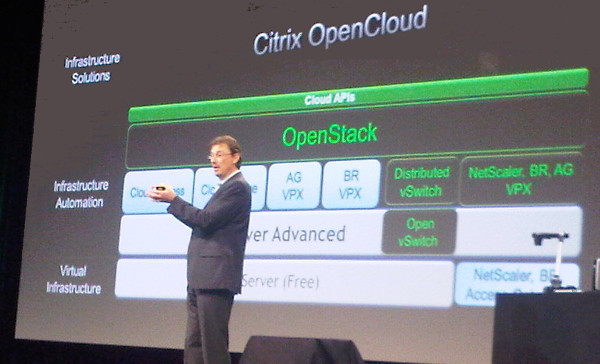
Despite the fact that Citrix is one of the ten most influential companies in the field of Cloud Computing , it is not often remembered when telling about OpenStack, I will try to correct this situation a bit. If you read the news about Citrix and OpenStack over the past 6 years, you get the impression that this story has three parts that at first glance could be called “Commitment”, “U-Turn” and “Return”, but in fact everything somewhat more complicated ...
“Project Olympus”
Like many other companies in the IT industry, Citrix reacted quite warmly to the start of the OpenStack project. Immediately after the announcement , the media wrote :
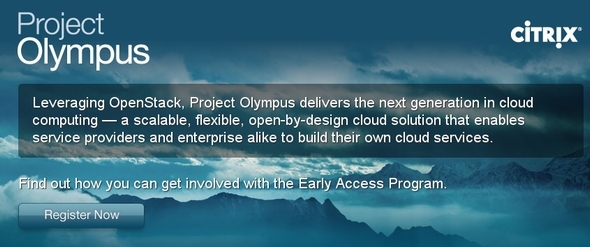
Project Olympus was created in close cooperation with Dell (as a supplier of hardware) and Rackspace (as one of the founders of the project). At that time, Citrix was the main sponsor of OpenStack, the second largest contributor to the project, and a member of the OpenStack policy definition board (this is an important detail, we’ll return to it).
')
Here I want to emphasize separately that Citrix in Project Olympus declared support not only for Xen, but also for “competing” hypervisors. This approach, which can be described as “you can use any other products with our software” (i.e., the independence of the cloud infrastructure from the solution provider) has been preserved, and is now one of the key benefits of Citrix solutions.
Amazon Web Services API
It is generally accepted that the Citrix turnaround from OpenStack to CloudStack occurred at the time Citrix bought “Cloud.com” - a small private company with 70 employees, developing IaaS CloudStack, however, in fact, there was no reversal. And what happened?
Look at the chronology of events - May 25, the announcement of the Project Olympus , and the news of the completion of the acquisition of Cloud.com on June 12, 2011 , i.e. in a month and a half. Obviously, the purchase negotiations were conducted more than one day and began even before the announcement of “Project Olympus”. This means that Citrix initially planned to work with the developers of both open IaaS platforms . And even more, according to some sources, Citrix wanted to combine the code base of both projects, taking the best from each of them.
Slide from the presentation on Citrix and Cloud.com plans after the merger:
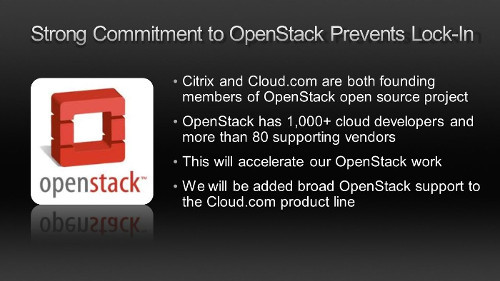
Thus, the purchase of CloudStack should not have affected Citrix’s attitude towards OpenStack. However, Citrix did become much more focused on CloudStack. Why did this happen? Of course, there was no official press release on this subject, but it is rumored that the reason for this was disagreement over decision-making issues in the OpenStack project. More specifically, we are talking about supporting the Amazon Web Services API (AWS), Rackspase allegedly categorically did not want to add support for this API in OpenStack.
When I wrote about problems with open projects , there was a statement that “the more successful an open source project is, the more large companies want to manage the code base themselves”. This is our case - the problem with the project management OpenStack decided only with the formation of the OpenStack Foundation and the transfer of the organization of the brand and project management functions.
Paradox. It turns out that Citrix was not able to achieve the adoption of the API (which was not related to the products of Citrix itself) in an open and independent project. At the same time, the key distinctive feature (purchased and developed by Citrix) IaaS CloudStack from the very beginning was independence from the type of hypervisor and support for various APIs (including API AWS). In other words, the reason for the “reversal” was not an attempt to redistribute the IaaS market and obtain financial benefits, but on the contrary, Citrix’s reluctance to abandon the policy of independence of the cloud-infrastructure .
Openstack foundation
Citrix officially became a member of the OpenStack Foundation in April 2015 , but this does not mean that since the “API conflict” until April 2015, Citrix has not contributed to the OpenStack project. We can recall how amazed journalists wrote :
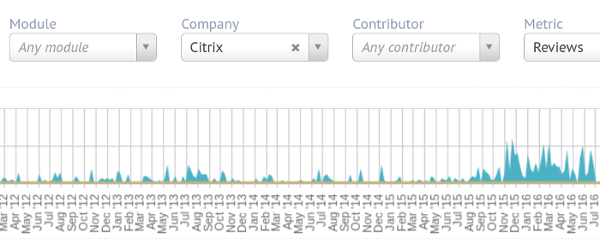
Here you can see that the code and patches in the Citrix OpenStack project went almost evenly (until the end of 2015) and although the company was not a member of the OpenStack Foundation, it did not refuse OpenStack. At the same time, it was possible to observe steps along the path of “equidistance” from open IaaS - Citrix first transferred CloudStack to the Apache Software Foundation community , and then completely sold its entire business associated with CloudStack (but promised to continue investing in the Apache CloudStack project) .
Summarizing...
We can say that Citrix is trying to apply a “platform approach” ( I wrote about this approach in the Xen story ) against Open Source IaaS when it does not compete with open source projects, but rather builds its products around them, thus trying to promote OpenStack and CloudStack (well, make some money on this, of course). Those. Citrix sees its products as an addition to existing IaaS open source .
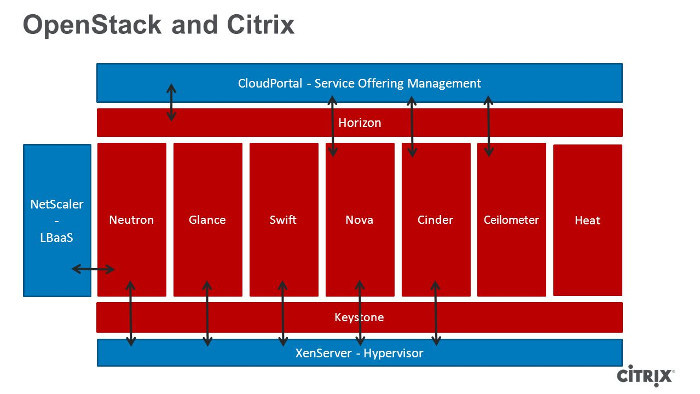
Using the example of Citrix, you can see how difficult it is to “find your place” for commercial companies in open source projects. Citrix tried to make a commercial IaaS based on open source, and to provide services for the introduction of "its" open IaaS and now uses it as a platform, complementing it with its own software. In my opinion, the relationship between Citrix and OpenStack are very interesting and undeservedly forgotten pages in the fate of this open IaaS platform.
ps: This version of events is not indisputable and the only true. If I missed something, supplement my story, write in the comments other facts known to you and your opinion regarding the Citrix contribution to the OpenStack project.

Despite the fact that Citrix is one of the ten most influential companies in the field of Cloud Computing , it is not often remembered when telling about OpenStack, I will try to correct this situation a bit. If you read the news about Citrix and OpenStack over the past 6 years, you get the impression that this story has three parts that at first glance could be called “Commitment”, “U-Turn” and “Return”, but in fact everything somewhat more complicated ...
“Project Olympus”
Like many other companies in the IT industry, Citrix reacted quite warmly to the start of the OpenStack project. Immediately after the announcement , the media wrote :
... we also see Citrix as the main player in this initiative ... There is no doubt that Citrix plans to link its products with IaaS OpenStack, and thus make their sharing more valuable. Citrix will probably be working on how to deploy windows software in OpenStack and promote the use of XenServer as a hypervisor (and not KVM). In addition, for sure, Citrix will be interested in OpenStack, as in the tool of rivalry with VMware.But then everything became even more interesting. In May 2011, Citrix talked about Project Olympus , this solution included the commercial version of the OpenStack distribution, the cloud-optimized XenServer hypervisor, as well as the infrastructure components of NetScaler Cloud Gateway and NetScaler Cloud Bridge. Thus, Citrix was the first large company to offer a commercial solution based on OpenStack.

Project Olympus was created in close cooperation with Dell (as a supplier of hardware) and Rackspace (as one of the founders of the project). At that time, Citrix was the main sponsor of OpenStack, the second largest contributor to the project, and a member of the OpenStack policy definition board (this is an important detail, we’ll return to it).
')
Here I want to emphasize separately that Citrix in Project Olympus declared support not only for Xen, but also for “competing” hypervisors. This approach, which can be described as “you can use any other products with our software” (i.e., the independence of the cloud infrastructure from the solution provider) has been preserved, and is now one of the key benefits of Citrix solutions.
Amazon Web Services API
It is generally accepted that the Citrix turnaround from OpenStack to CloudStack occurred at the time Citrix bought “Cloud.com” - a small private company with 70 employees, developing IaaS CloudStack, however, in fact, there was no reversal. And what happened?
Look at the chronology of events - May 25, the announcement of the Project Olympus , and the news of the completion of the acquisition of Cloud.com on June 12, 2011 , i.e. in a month and a half. Obviously, the purchase negotiations were conducted more than one day and began even before the announcement of “Project Olympus”. This means that Citrix initially planned to work with the developers of both open IaaS platforms . And even more, according to some sources, Citrix wanted to combine the code base of both projects, taking the best from each of them.
Slide from the presentation on Citrix and Cloud.com plans after the merger:

Thus, the purchase of CloudStack should not have affected Citrix’s attitude towards OpenStack. However, Citrix did become much more focused on CloudStack. Why did this happen? Of course, there was no official press release on this subject, but it is rumored that the reason for this was disagreement over decision-making issues in the OpenStack project. More specifically, we are talking about supporting the Amazon Web Services API (AWS), Rackspase allegedly categorically did not want to add support for this API in OpenStack.
When I wrote about problems with open projects , there was a statement that “the more successful an open source project is, the more large companies want to manage the code base themselves”. This is our case - the problem with the project management OpenStack decided only with the formation of the OpenStack Foundation and the transfer of the organization of the brand and project management functions.
Paradox. It turns out that Citrix was not able to achieve the adoption of the API (which was not related to the products of Citrix itself) in an open and independent project. At the same time, the key distinctive feature (purchased and developed by Citrix) IaaS CloudStack from the very beginning was independence from the type of hypervisor and support for various APIs (including API AWS). In other words, the reason for the “reversal” was not an attempt to redistribute the IaaS market and obtain financial benefits, but on the contrary, Citrix’s reluctance to abandon the policy of independence of the cloud-infrastructure .
Openstack foundation
Citrix officially became a member of the OpenStack Foundation in April 2015 , but this does not mean that since the “API conflict” until April 2015, Citrix has not contributed to the OpenStack project. We can recall how amazed journalists wrote :
But, it turns out, in 2013, Citrix, along with CloudStack, to a certain extent continues to invest in OpenStack and expects to support its customers on both cloud platforms.And further:
According to Dholakia [vice president and general manager of Citrix for cloud platforms], the current market makes a choice towards free code and there is no real rivalry between the free OpenStack and CloudStack platforms. “By and large, our competitor is VMware, and therefore we are pleased that many open source projects are flourishing and there are all the conditions for this to continue,” said Dholakia.Thus, in fact, Citrix was working in parallel with OpenStack and CloudStack. This can be seen on this link here .

Here you can see that the code and patches in the Citrix OpenStack project went almost evenly (until the end of 2015) and although the company was not a member of the OpenStack Foundation, it did not refuse OpenStack. At the same time, it was possible to observe steps along the path of “equidistance” from open IaaS - Citrix first transferred CloudStack to the Apache Software Foundation community , and then completely sold its entire business associated with CloudStack (but promised to continue investing in the Apache CloudStack project) .
Summarizing...
We can say that Citrix is trying to apply a “platform approach” ( I wrote about this approach in the Xen story ) against Open Source IaaS when it does not compete with open source projects, but rather builds its products around them, thus trying to promote OpenStack and CloudStack (well, make some money on this, of course). Those. Citrix sees its products as an addition to existing IaaS open source .

Using the example of Citrix, you can see how difficult it is to “find your place” for commercial companies in open source projects. Citrix tried to make a commercial IaaS based on open source, and to provide services for the introduction of "its" open IaaS and now uses it as a platform, complementing it with its own software. In my opinion, the relationship between Citrix and OpenStack are very interesting and undeservedly forgotten pages in the fate of this open IaaS platform.
ps: This version of events is not indisputable and the only true. If I missed something, supplement my story, write in the comments other facts known to you and your opinion regarding the Citrix contribution to the OpenStack project.
Source: https://habr.com/ru/post/305598/
All Articles